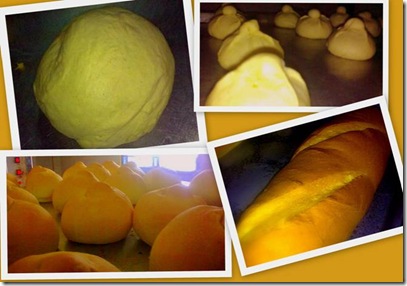PAN ANDINO
Día 1: Pipa
30 gramos de harina de fuerza
50 gramos de agua
10 gramos de azúcar
15 gramos de papelón rallado
Se mezcla y se deja en reposo por 24 horas.
Día 2: La Masa
550 grs de harina
150 grs de agua
10 grs. de levadura seca instantánea
5 grs de sal
2 huevos batido
15 grs de leche en polvo
30 grs de manteca
170 grs de azúcar
10 grs de papelón derretido o rallado
5 grs de miel
5 grs de esencia de vainilla
5 grs. de mezcla de canela, clavo de olor y guayabita
Día 2: La Masa
550 grs de harina
150 grs de agua
10 grs. de levadura seca instantánea
5 grs de sal
2 huevos batido
15 grs de leche en polvo
30 grs de manteca
170 grs de azúcar
10 grs de papelón derretido o rallado
5 grs de miel
5 grs de esencia de vainilla
5 grs. de mezcla de canela, clavo de olor y guayabita
Toda la pipa
Elaboración:
1.Colocar todos los ingredientes en la amasadora y amasar hasta que la masa esté suave y elástica, y no pegajosa. Es una masa bien compacta y con tendencia a ser seca. Se deja reposar 30 minutos.
2. En una superficie enharinada, extender con el rodillo, doblar y volver a extender con el rodillo, realizar esta acción varias 24 veces.
3. Dividir la masa en dos, cada mitad en forma de bola, 10 min de reposo y dar forma alargada a los panes.
4. Colocar en la bandeja y cubrir ligeramente con un plástico para que tengan espacio para crecer. Dejar levar durante 12 horas a temperatura ambiente si está muy frio hay que dejarlo un poco más, pueden llegar a tardar hasta 16 horas.
Día 3: Horneado
1. Pre-calentar el horno a 180 °C.
2. Hacer algunos cortes decorativos a las hogazas de pan, con una hojilla.
3. Hornear durante 30 a 40 minutos aprox. hasta que el pan tenga un ligero color dorado.
4. Al sacarlos, untar un poco de mantequilla derretida y espolvorear con azúcar.
5. Dejar enfriar sobre una rejilla.
1.Colocar todos los ingredientes en la amasadora y amasar hasta que la masa esté suave y elástica, y no pegajosa. Es una masa bien compacta y con tendencia a ser seca. Se deja reposar 30 minutos.
2. En una superficie enharinada, extender con el rodillo, doblar y volver a extender con el rodillo, realizar esta acción varias 24 veces.
3. Dividir la masa en dos, cada mitad en forma de bola, 10 min de reposo y dar forma alargada a los panes.
4. Colocar en la bandeja y cubrir ligeramente con un plástico para que tengan espacio para crecer. Dejar levar durante 12 horas a temperatura ambiente si está muy frio hay que dejarlo un poco más, pueden llegar a tardar hasta 16 horas.
Día 3: Horneado
1. Pre-calentar el horno a 180 °C.
2. Hacer algunos cortes decorativos a las hogazas de pan, con una hojilla.
3. Hornear durante 30 a 40 minutos aprox. hasta que el pan tenga un ligero color dorado.
4. Al sacarlos, untar un poco de mantequilla derretida y espolvorear con azúcar.
5. Dejar enfriar sobre una rejilla.




